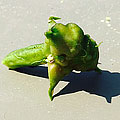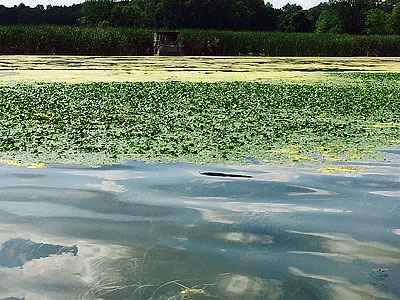- By Hilary Lambert
- Around Town
 Print
Print  Thanks to sharp-eyed lake scientist Lisa Cleckner of the Finger Lakes Institute, a Water Chestnut plant was spotted in mid-August floating on Cayuga Lake just south of Canoga Marsh on the lake’s northwest shoreline.
Thanks to sharp-eyed lake scientist Lisa Cleckner of the Finger Lakes Institute, a Water Chestnut plant was spotted in mid-August floating on Cayuga Lake just south of Canoga Marsh on the lake’s northwest shoreline. The Seneca County Soil and Water Conservation District’s aquatic plant harvesting team scouted the area and located an infestation east of Canoga Marsh approximately ½ acre in size. This area was mechanically harvested, with the plants removed from the lake.
Water Chestnut plant (Trapa natans L.). Not the same plant as the one used in Asian cooking.Conservation District Manager Jim Malyj reported that seeds (commonly referred to as nuts) were removed before they had reached maturity, preventing them from becoming viable seeds which would grow next summer.

On August 26, Malyj’s team expanded the search, covering the shoreline from Cayuga Lake State Park to the Red Jacket Yacht Club. They found and collected a few more plants, went north to the outlet, under the railroad bridge and into the area west of the Village of Cayuga. Although the shallow water is vulnerable to the establishment of Water Chestnut, they found none there at this time.
- Please look for and report Water Chestnut: The public is asked to keep an eye out for Water Chestnut infestations in shallow, still waters of the lake and adjoining creeks, and report sightings to Jim Malyj, Hilary Lambert, or Hilary Mosher (contact information, above). Infestations can be removed via machine or by hand if they are caught early when the floating patch is small.
- Why Water Chestnut is a problem: The dense growth of water chestnut can effectively choke a waterbody, making boating, fishing and swimming nearly impossible. This weed also shades out native aquatic plants and offers little value to wildlife. The seeds have sharp spines that can inflict puncture wounds. This is not the same plant as the water chestnut used in Asian cooking. Other lakes in the region have dense, long-term Water Chestnut populations. Communities are spending a lot of time, effort and money on removal and control. Let’s work together to minimize this problem on Cayuga Lake!
v11i34
